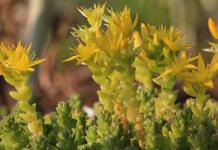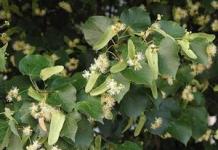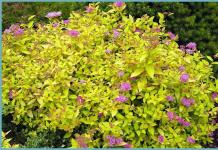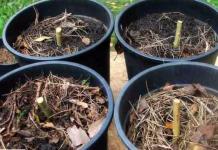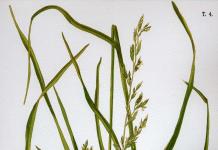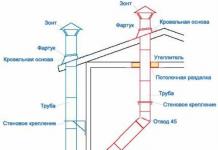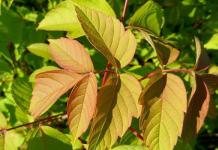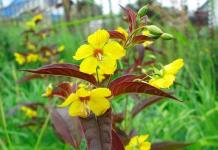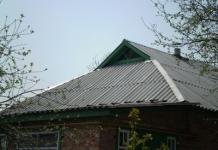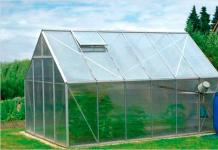Monetary loosestrife is a perennial herbaceous plant with creeping stems up to 80 cm long. The stems are tetrahedral, slightly branched, roots grow in places of nodes, growing into the soil. The leaves of the plant are opposite, rounded, entire along the edge with short petioles. Golden-yellow, large, solitary axillary flowers are distinguished by a funnel-shaped calyx, separate to the very base. The flowering period of the plant is June-July.
The coined loosestrife reproduces vegetatively. The plant prefers damp places, grows in water meadows, in thickets of bushes, it can be seen on the outskirts of swamps. The plant's leaves are similar to willow leaves, hence the Russian name is loosestrife.
Flowers grow well on fertile soils, they prefer shade. They are unpretentious, with sufficient humidity grow, turning into luxurious plants. In the cold season, loosestrife is placed in winter gardens.
loosestrife flowers
Looseflower flowers are useful and aesthetically beautiful. There are many varieties of this species, growing in the wild and naturalized, adapted to different climatic conditions of various natural zones. This is an excellent medicinal raw material used in folk medicine and as a decoration for lawns and balconies in the summer.Spotted loosestrife
Point loosestrife has a light brown long rhizome, branched at the end and forming a whorl of 4-6 underground shoots. The pubescent stem is erect, with a small number of branches and sessile broadly lanceolate leaves. Lemon-yellow flowers are placed at the top of the stem in large numbers.This species grows on any soil, but slightly acidic light and medium loams are an ideal environment for the normal development of the plant. In nature, spotted loosestrife is found in the forests of Central and Western Europe with moist soil. Blooms from June to July (30-35 days). The plant looks spectacular in composite plantings near artificial reservoirs and in mixborders.
Common loosestrife
Common loosestrife is perfect for landscape design. This species blooms with small bell-shaped flowers collected in paniculate inflorescences at the end of June. The petals are yellow, shiny, reddish-brown at the base of the corolla, attracting insects for pollination. The plant is a good honey plant.Common loosestrife has astringent, choleretic, tonic, anti-inflammatory properties. An infusion of herbs is drunk with convulsions, general weakness, with hemoptysis and bleeding. An infusion of vodka is taken for jaundice and liver diseases: 2 tablespoons of common loosestrife grass are infused for several days in a glass of vodka, 20 drops diluted in a glass of water are consumed 3 times a day before meals.
Beaujolais loosestrife
Beaujolais loosestrife is a rhizomatous perennial plant. An unusual perennial with a height of 45–90 cm has a delightful appearance. Wine-red, almost black flowers of the plant are collected in spikes. Silver-green lanceolate leaves have a slight corrugation along the edge. For this type of loosestrife, fertile garden soils are preferred; plants are used as borders, arrays, and for tamping bushes.loosestrife lily of the valley
The loosestrife lily of the valley has a straight, furrowed, leafy stem. An adult plant reaches a height of 60 cm. This species is interesting in spike-shaped inflorescences with small star-shaped white flowers located at the top of the stem. The leaves are alternate, glaucous below, with a surface dotted with dots.This species grows in mountain forests, in dry meadows of the Far East. Loosestrife roots contain saponins, triterpene compounds and are used in the recovery of the body after suffering hemorrhages and bleeding.
Loosestrife
The loosestrife is a rhizomatous plant with straight, slightly branched shoots, can reach 1.2 m in height. The leaves are alternate, sessile, oval-lanceolate, long (15 cm). Apical dense spike-shaped inflorescences from 15 to 40 cm long consist of small star-shaped white flowers. The plant is moisture-loving, prefers partial shade, grows excellently on loose fertile soils, winter-hardy.Spotted loosestrife Lysimachia
Spotted loosestrife Lysimachia is used in folk medicine in the form of infusions for diarrhea, jaundice, and scurvy. Crushed fresh leaves of the plant heal poorly healing wounds. The plant contains a large amount of saponins, because of this, it is not of interest to animals. Incredibly beautiful flowers allow the use of loosestrife in landscape design, it is unpretentious in care and grows rapidly.Verbeinik "Alexander"
This herbaceous perennial, reaching a height of 40-50 cm, with sessile broad-lanceolate leaves, has lemon-yellow flowers, collected in large numbers on a slightly branched top of the stem. This species blooms for 30-35 days in June-July. It develops luxuriously only in sunny areas with fertile soil. Excellent combined with other plants in group plantings near ponds and in mixborders. When designing flower beds, it must be taken into account that this plant has a curtain that quickly grows in diameter and displaces less hardy plants.Purple loosestrife
Purple loosestrife is a perennial rhizomatous plant with attractively colored leaves and inflorescences. It forms small bushes with upright shoots. This species has a broadly lanceolate, smooth leaf blade. Yellow, with a red "eye" in the center of the corolla, small flowers are collected in sparse inflorescences at the tops. The plant is photophilous, loves moisture, grows poorly on "poor" soils.loosestrife
The loosestrife is endowed with erect stems 45 cm tall. Its leaves are paired, wine-red, broadly lanceolate. At the ends of the stems and in the axils of the upper leaves, small lemon-yellow flowers are formed, collected in a loose inflorescence. The flowering period of this species is August-September. The plant loves sunny areas, is used in contrasting flower beds, frost-resistant. A wild plant chooses meadows, edges, glades. The birthplace of the loosestrife is North America.Useful properties of loosestrife
The loosestrife has been famous for its useful properties since ancient times. The presence of hyperin, rutin, phenolcarboxylic acids and their derivatives in the roots, leaves and flowers has been scientifically confirmed. The content in the plant of the enzyme primverase, silicic acid was revealed. All parts of the plant contain saponins, tannins, carbohydrates, nitrogen-containing compounds.The use of loosestrife
In folk medicine, loosestrife has found wide application. With various gastrointestinal diseases, the plant is the first assistant on the path to recovery. Bites of animals, snakes, insects will not be painful and will not cause complications if you start taking loosestrife-based products in time and apply dressings soaked in fresh juice. Skin inflammation, some types of eczema, and thrush are excellently treated with loosestrife. Those suffering from dust lung disease tend to have difficulty coughing; in order to be able to easily get rid of mucus, they are recommended to use loosestrife in the form of tea.Young stems of the plant are used for infusions and decoctions, in combination with honey it is an excellent medicine for coughs and shortness of breath. Dry roots, ground into powder, effectively heal wounds, reduce pain during various inflammations, and stop bleeding in case of damage to blood vessels. Infusions and decoctions of loosestrife are used for constipation, bruises, peptic ulcer, gynecological diseases, anemia, scurvy, migraine. Rapid resorption of tumors, swelling with bruises, elimination of hernias.
Contraindications to the use of loosestrife
Loosestrife is contraindicated in certain blood diseases, it is dangerous to take funds based on loosestrife for thrombosis, varicose veins, sclerosis of the vessels of the extremities. It is also not recommended to use the plant for patients suffering from hypertension. You can not give decoctions of herbs for the treatment of dry cough to children.
One day, enjoying the beauty of the world around her, the girl noticed a majestic flower - loosestrife. After some thought, she wrote a short poem about this plant. In it, the girl compared the flower with the royal symbol of power - the scepter and called him the ruler of the power of flowers. This is how this sophisticated flower appears before us.
 The loosestrife belongs to the genus of perennial plants belonging to the Primrose family. Some of its representatives live one or two seasons. The plant got its name because of the shape of the leaves, which are very similar to willow leaves (as all types of willow trees were called in ancient times). According to another version, the loosestrife got its name in memory of the outstanding commander of Alexander the Great - Lysimachus. For a long time it was believed that it was he who discovered this majestic plant. So it really is or not, but the loosestrife really resembles a colorful royal scepter.
The loosestrife belongs to the genus of perennial plants belonging to the Primrose family. Some of its representatives live one or two seasons. The plant got its name because of the shape of the leaves, which are very similar to willow leaves (as all types of willow trees were called in ancient times). According to another version, the loosestrife got its name in memory of the outstanding commander of Alexander the Great - Lysimachus. For a long time it was believed that it was he who discovered this majestic plant. So it really is or not, but the loosestrife really resembles a colorful royal scepter.
External description of a stately flower
 In the natural environment, there are more than a hundred different species of this plant. Most of them grow in the Northern Hemisphere, although some species have been found in the south of the American continent and in Africa. More than 70 varieties of the stately flower grow in China. Many species of loosestrife can be found in Russia, the Caucasus and even Siberia. As you can see, the flower conquered many expanses of the inhabited earth. After reviewing a brief description of loosestrife, you can get to know him better. And someday this flower will become king in your favorite summer cottage.
In the natural environment, there are more than a hundred different species of this plant. Most of them grow in the Northern Hemisphere, although some species have been found in the south of the American continent and in Africa. More than 70 varieties of the stately flower grow in China. Many species of loosestrife can be found in Russia, the Caucasus and even Siberia. As you can see, the flower conquered many expanses of the inhabited earth. After reviewing a brief description of loosestrife, you can get to know him better. And someday this flower will become king in your favorite summer cottage.
 The plant has erect shoots, on which green leaves are arranged in the next order. The shape of the plate is lanceolate or oval. Charming buds are located along the green shoot, and there are such shades:
The plant has erect shoots, on which green leaves are arranged in the next order. The shape of the plate is lanceolate or oval. Charming buds are located along the green shoot, and there are such shades:

They are collected in inflorescences resembling an ear or flower brushes. On some specimens, there are single buds or several in leaf axils.  Loosestrife refers to creeping herbaceous plants with erect shoots. From the side it looks like a miniature flowering shrub.
Loosestrife refers to creeping herbaceous plants with erect shoots. From the side it looks like a miniature flowering shrub.
Features of planting plants and proper care
 A majestic flower can be planted and propagated in a summer cottage by sowing seeds and vegetatively. The loosestrife planting and care shown in the photo require simple rules to be followed. First of all, it is important to choose the right place. Almost all varieties of plants love penumbra or shaded areas of the garden.
A majestic flower can be planted and propagated in a summer cottage by sowing seeds and vegetatively. The loosestrife planting and care shown in the photo require simple rules to be followed. First of all, it is important to choose the right place. Almost all varieties of plants love penumbra or shaded areas of the garden.
Purple loosestrife thrives well in open areas, so this fact should be taken into account when planting a flower.
The next stage is fertile loose soil. It can be fertilized with compost or humus. It is desirable that it be sufficiently saturated with moisture. A suitable option if groundwater lies nearby. Some loosestrife species are planted directly into the water, where they thrive.
Leaving and planting loosestrife in open ground is carried out in the usual way. First, dig a small hole. Then, the roots of the plant are carefully placed in it and covered with earth. The topsoil is compacted and watered abundantly.
In order for the plants to receive enough light, air and nutrients from the soil, the distance between them must be at least 50 cm.
When the plant takes root well in the front garden, it starts up a large number of shoots.  After some time, loosestrife grows and occupies almost the entire area of the site. Therefore, it must be transplanted in time. Although it can freely grow in one place for a whole decade, the flower should be planted in the second year. The best time for this is early spring or late autumn.
After some time, loosestrife grows and occupies almost the entire area of the site. Therefore, it must be transplanted in time. Although it can freely grow in one place for a whole decade, the flower should be planted in the second year. The best time for this is early spring or late autumn.
You can also plant loosestrife with the help of seeds. If sowing is carried out in the warm season, they must first be held for 2 months in the cold. The collected seeds are placed in the refrigerator, where the vegetables are stored for the specified period. After that, they are sown. During the autumn planting, the seeds do not need preliminary cold exposure. Winter frosts will do it naturally. And in the spring, friendly young shoots will appear from the soil.
 Planting loosestrife by sowing seeds can also be done indoors. Planting material is sown on the moistened surface of the soil, consisting of and sand. Cover the boxes with glass or film, and then put in a bright room. The optimum temperature should be at least 15 degrees. After 2 weeks, green shoots will appear on the surface of the soil. After another week or two, they dive into separate pots, where they gain strength. After that, the flowers are planted in the front garden.
Planting loosestrife by sowing seeds can also be done indoors. Planting material is sown on the moistened surface of the soil, consisting of and sand. Cover the boxes with glass or film, and then put in a bright room. The optimum temperature should be at least 15 degrees. After 2 weeks, green shoots will appear on the surface of the soil. After another week or two, they dive into separate pots, where they gain strength. After that, the flowers are planted in the front garden.
In order for the plants to gradually get used to the outdoor temperature, the room must be regularly ventilated. Thanks to this, young shoots are hardened and feel great after planting in open ground.
You can also propagate loosestrife by dividing the bush. The plant extracted from the soil is divided into several parts. The main thing is that each of them has developed roots. Such plants will bloom next season.
 A photo of a coined loosestrife, the care and planting of which is carried out by dividing the cuttings, causes unprecedented delight. The process begins by placing the cuttings in vessels of water. Being in the liquid, they release the roots. After that, they are planted in a shady place in a summer cottage in moist soil. Over time, the bushes will bloom to the delight of the household.
A photo of a coined loosestrife, the care and planting of which is carried out by dividing the cuttings, causes unprecedented delight. The process begins by placing the cuttings in vessels of water. Being in the liquid, they release the roots. After that, they are planted in a shady place in a summer cottage in moist soil. Over time, the bushes will bloom to the delight of the household.
Often for decoration, loosestrife is an indispensable plant. It is used in the formation of flower front gardens, as a background plant. Used to decorate coastal areas of domestic ponds and borders. The loosestrife fits perfectly into the alpine hill, making it an original creation of human hands. Sometimes the plant is simply planted as a free-standing flower to draw attention to the main landscape design. Creeping varieties are used for hanging planters and high flower beds. 
high flower beds
 Making a home pond with a loosestrife
Making a home pond with a loosestrife
 Monetary loosestrife on an elevated flower bed
Monetary loosestrife on an elevated flower bed
 Composition: loosestrife at the curb
Composition: loosestrife at the curb
 Coined loosestrife on the shore of a domestic pond
Coined loosestrife on the shore of a domestic pond
 Among the lush kingdom of flowers
Among the lush kingdom of flowers
Popular types of proud flower
For some summer residents, the proud "owner of the flower power" - loosestrife, is one of the favorites of landscape design. The plant is especially valued for the abundance of various varieties that grow freely in Russia. Looking closely at the stately flower, you can see the many shapes and shades that are inherent in different varieties.
Common loosestrife
 This pretty plant has a tall straight stem. It is not covered with bark and does not have any branches. From the horizontal winding rhizome upright shoots rise in large numbers. Most often, flowers reach 50 cm, and some giants grow up to a meter in height. Throughout the stem of the common loosestrife, whorled foliage grows from top to bottom. It comes in a narrow shape with pointed tips. The lower leaves are painted light green, the upper ones are more saturated with greenery. Some specimens are distinguished by a scarlet tint of leaves.
This pretty plant has a tall straight stem. It is not covered with bark and does not have any branches. From the horizontal winding rhizome upright shoots rise in large numbers. Most often, flowers reach 50 cm, and some giants grow up to a meter in height. Throughout the stem of the common loosestrife, whorled foliage grows from top to bottom. It comes in a narrow shape with pointed tips. The lower leaves are painted light green, the upper ones are more saturated with greenery. Some specimens are distinguished by a scarlet tint of leaves.
 At the very top of the erect stem are paniculate inflorescences. Each of them is decorated with pretty flowers located close to each other. The buds consist of five individual delicate petals that surround the corolla with the ovary and stamens. As a rule, the inflorescences are colored yellow, although orange, burgundy and snow-white options are also found. The plant blooms in summer, after which balls with a large number of seeds appear instead of buds.
At the very top of the erect stem are paniculate inflorescences. Each of them is decorated with pretty flowers located close to each other. The buds consist of five individual delicate petals that surround the corolla with the ovary and stamens. As a rule, the inflorescences are colored yellow, although orange, burgundy and snow-white options are also found. The plant blooms in summer, after which balls with a large number of seeds appear instead of buds.
Common loosestrife has medicinal properties. Tinctures or decoctions from it are used as a tonic and anti-inflammatory agent. It is often used as an astringent and choleretic natural substance.
Monetary loosestrife (monetary)
 The plant belongs to the family of perennial herbs. It has creeping horizontal stems about 80 cm long. Nodules appear on them, on which small roots grow. Thanks to them, the plant successfully grows throughout the territory. He loves fertile soil and shady places. In nature, it is found in the shade of low shrubs, in wet meadows or on the outskirts of swampy areas.
The plant belongs to the family of perennial herbs. It has creeping horizontal stems about 80 cm long. Nodules appear on them, on which small roots grow. Thanks to them, the plant successfully grows throughout the territory. He loves fertile soil and shady places. In nature, it is found in the shade of low shrubs, in wet meadows or on the outskirts of swampy areas.
 The leaves of the loosestrife are opposite, slightly rounded in shape. Their edges are solid, green in color. The buds grow in the axils of the leaf plate. They are usually large and solitary. The color is golden yellow, the calyx is funnel-shaped, the petals do not connect to each other. The flowering period is mid-summer.
The leaves of the loosestrife are opposite, slightly rounded in shape. Their edges are solid, green in color. The buds grow in the axils of the leaf plate. They are usually large and solitary. The color is golden yellow, the calyx is funnel-shaped, the petals do not connect to each other. The flowering period is mid-summer.
The monetized loosestrife loves shaded areas of the garden and fertile soil. By fulfilling only these two requirements, one can already achieve success in growing this plant.
Spotted loosestrife
 The flower of this variety is distinguished by a brown rhizome, which has several branches. From them under the ground shoots depart. Thanks to this, the plant grows wonderfully throughout the front garden.
The flower of this variety is distinguished by a brown rhizome, which has several branches. From them under the ground shoots depart. Thanks to this, the plant grows wonderfully throughout the front garden.
The erect stalk of loosestrife has a delicate edge. Unlike other species, there are several branches on the shoots. Along each of them are wide lanceolate leaves lemon or yellow buds are placed in large numbers along a dense stem.
loosestrife lily of the valley
 The name of the plant hints at the fact that outwardly it resembles lilies of the valley. And indeed it is. The loosestrife lily of the valley has a stable dense stem, on which next leaves are located from top to bottom. From below they are slightly bluish, and from above they are dotted with small dots. During flowering, the plant puts on spike-shaped buds, consisting of many small flowers. They are painted in a snow-white color and sit at the very top of the stem. A flower grows up to 45 cm and fits beautifully into any landscape design.
The name of the plant hints at the fact that outwardly it resembles lilies of the valley. And indeed it is. The loosestrife lily of the valley has a stable dense stem, on which next leaves are located from top to bottom. From below they are slightly bluish, and from above they are dotted with small dots. During flowering, the plant puts on spike-shaped buds, consisting of many small flowers. They are painted in a snow-white color and sit at the very top of the stem. A flower grows up to 45 cm and fits beautifully into any landscape design.
Loosestrife
 This variety of loosestrife is often called lily of the valley, for the similarity of its underground rhizome with it. It has the same pinkish-white color, but is slightly thicker than that of the lily of the valley. The loosestrife has an upright stem (about 20 cm in height), covered with foliage on all sides. The inflorescence is collected in a dense spike, filled with many white buds. It blooms in mid-summer and pleases the eye for 3 weeks.
This variety of loosestrife is often called lily of the valley, for the similarity of its underground rhizome with it. It has the same pinkish-white color, but is slightly thicker than that of the lily of the valley. The loosestrife has an upright stem (about 20 cm in height), covered with foliage on all sides. The inflorescence is collected in a dense spike, filled with many white buds. It blooms in mid-summer and pleases the eye for 3 weeks.
loosestrife cletroides
 This type of plant is also classified as a lily-of-the-valley variety of loosestrife. The flower grows to a height of up to 80 cm. Opposite rounded leaves grow on its high dense shoots. Cletroides loosestrife blooms with snow-white spike-shaped buds. From a distance, it resembles the original green bushes in the bride's white attire. They are used to decorate a personal plot: they are planted as living borders on, in alpine slides and off the coast of artificial pools.
This type of plant is also classified as a lily-of-the-valley variety of loosestrife. The flower grows to a height of up to 80 cm. Opposite rounded leaves grow on its high dense shoots. Cletroides loosestrife blooms with snow-white spike-shaped buds. From a distance, it resembles the original green bushes in the bride's white attire. They are used to decorate a personal plot: they are planted as living borders on, in alpine slides and off the coast of artificial pools.
Purple loosestrife (ciliated)
 This perennial plant forms miniature bushes with erect stems. All of them are covered with smooth lanceolate leaves of wine-red color. Purple loosestrife is famous for its original inflorescences, which are located on the tops of slender shoots. The buds are collected in small bunches that shine with lemon color in the sun. The flower loves open light areas with moist fertile soil.
This perennial plant forms miniature bushes with erect stems. All of them are covered with smooth lanceolate leaves of wine-red color. Purple loosestrife is famous for its original inflorescences, which are located on the tops of slender shoots. The buds are collected in small bunches that shine with lemon color in the sun. The flower loves open light areas with moist fertile soil.
Often, the ciliary loosestrife grows up to 45 cm in height, which gives it a majestic appearance. The plant begins to bloom at the end of August and can continue until mid-September. It is not afraid of harsh winters, as it is considered a frost-resistant variety. In its natural environment, it is found in wet meadows near water bodies.
 I especially want to highlight the original variety of the ciliated species - loosestrife firecracker. It is able to grow up to a meter high, which looks pretty nice against the background of other greenery. The erect shoots are alternately covered with lanceolate leaves pointed at the tips. Inflorescences appear in the axils of the leaf plates at the top of the shoot.
I especially want to highlight the original variety of the ciliated species - loosestrife firecracker. It is able to grow up to a meter high, which looks pretty nice against the background of other greenery. The erect shoots are alternately covered with lanceolate leaves pointed at the tips. Inflorescences appear in the axils of the leaf plates at the top of the shoot.  Bell buds are bright yellow and bloom in early autumn. Bloom until October. Frost-resistant. They feel comfortable in the open areas of the backyard territory of the garden.
Bell buds are bright yellow and bloom in early autumn. Bloom until October. Frost-resistant. They feel comfortable in the open areas of the backyard territory of the garden.
loosestrife beaujolais
 This delightful perennial grows up to a meter high and has unusual inflorescences. They are dark red in color and are collected in dense spikes. Beaujolais loosestrife has silver-green lanceolate leaves slightly corrugated along the edges. They are wonderfully combined with dark buds that appear during flowering. The plant prefers fertile soils that retain moisture for a long time. They are widely used to decorate summer cottages. Planted to mark the territory instead of curbs.
This delightful perennial grows up to a meter high and has unusual inflorescences. They are dark red in color and are collected in dense spikes. Beaujolais loosestrife has silver-green lanceolate leaves slightly corrugated along the edges. They are wonderfully combined with dark buds that appear during flowering. The plant prefers fertile soils that retain moisture for a long time. They are widely used to decorate summer cottages. Planted to mark the territory instead of curbs.
Verbeinik Alexander
 Majestic herbaceous perennial grows from 40 to 50 cm in height. On its erect stems are sessile broadly lanceolate leaves. Along the entire shoot, in the middle of summer, many delicate flowers appear. They are collected in small bouquets and shine brightly with lemon color against the background of dense greenery of the plant. Verbeinik Alexander feels luxuriously on fertile land, where there is a lot of air and light. He is especially comfortable in combined plantings of flowers near water bodies.
Majestic herbaceous perennial grows from 40 to 50 cm in height. On its erect stems are sessile broadly lanceolate leaves. Along the entire shoot, in the middle of summer, many delicate flowers appear. They are collected in small bouquets and shine brightly with lemon color against the background of dense greenery of the plant. Verbeinik Alexander feels luxuriously on fertile land, where there is a lot of air and light. He is especially comfortable in combined plantings of flowers near water bodies.  Often loosestrife is used to create mixborders that bloom continuously until late autumn. Just in such an environment, he looks like the ruler of the kingdom of flowers.
Often loosestrife is used to create mixborders that bloom continuously until late autumn. Just in such an environment, he looks like the ruler of the kingdom of flowers.
Before designing a flower garden, one should take into account the property of this variety to grow rapidly. Otherwise, loosestrife will force out weak plants, which will violate the overall harmony of the flower bed.
No chance for pests
 It is not for nothing that the loosestrife is called the ruler of flower power, because the plant almost never gets sick. It surrenders only to living pests: aphids and weevils. You can cope with the invasion of such ill-wishers as aphids using special preparations.
It is not for nothing that the loosestrife is called the ruler of flower power, because the plant almost never gets sick. It surrenders only to living pests: aphids and weevils. You can cope with the invasion of such ill-wishers as aphids using special preparations.  Weevils impersonate affected leaves. If you find merged specimens, it is advisable to immediately start collecting them. Lost time will lead to the appearance of beetle larvae, which imperceptibly undermine a healthy plant.
Weevils impersonate affected leaves. If you find merged specimens, it is advisable to immediately start collecting them. Lost time will lead to the appearance of beetle larvae, which imperceptibly undermine a healthy plant.
Giving an objective assessment of the stately flower, it can be noted that it does not require special care. Easily adapts to new territory. It looks pretty good in landscape design. It has many beneficial properties that improve our health. Among them can be noted astringent, tonic and choleretic effect. Growing such a flower in a suburban area brings only positive emotions. It might be worth trying and enjoying its flowery grandeur.
Video about planting a perennial loosestrife
Monetary loosestrife is a perennial herbaceous plant, a representative of the numerous genus of loosestrife, the Primrose family. Its long creeping shoots 20-60 cm long can take root at the nodes, the leaves are round, green or yellow. Flowers with a diameter of 18-30 mm, bright yellow, have five petals collected in a star-shaped calyx. The plant is widespread in the northern hemisphere. On the territory of Russia, it naturally grows in the European part and Ciscaucasia.
In landscape design it is used as a groundcover. It is valued for its unpretentiousness, rapid growth and high decorative effect. Monetary loosestrife in nature grows along the banks of rivers, near swamps, in floodplain meadows. In our gardens, of course, it will be best to feel near artificial reservoirs or in damp places, but it can also be used to decorate arid zones where water enters several times a year. True, there it will not be so beautiful, and it will grow slowly, but the choice of beautiful plants for arid places is not so great.

Growing loosestrife monet
In addition, the loosestrife can grow both in the shade and in the scorching sun. Plants with green leaves will do best in the shade, with yellow leaves in the sun. If you plant a loosestrife with yellow leaves in the shade, they will soon lose their yellow color and become light green.
It blooms profusely and is very attractive. The flowers are really very beautiful rich color, large and expressive.
From loosestrife you can make a lawn, very beautiful all year round and easy to care for. The plant is resistant to trampling, with good watering it grows very well, does not require a haircut, and requires a minimum of care to maintain a very high decorative effect. Moreover, such a lawn can be done both in the sun and in the shade. The lawn of loosestrife with yellow leaves looks very interesting, one part of which is in the sun most of the day, and the other is in the shade. It seems that it does not consist of one variety of plant, but of two, and of different colors.
Coin Loosehair Care
If you have an artificial pond on your site, this plant will become its pearl. The monetized loosestrife looks very beautiful, planted right on the shore, some of the shoots of which are located right in the water and bloom in the water, and feel great.

How to water loosestrife monet
A dry mound in the sun, where nothing but stonecrops and succulents wants to grow, can be decorated with the same loosestrife, although it will grow slowly and not look as chic as near the water. If possible, water it in the heat at least from a watering can - this is enough, its root system is superficial. They can also decorate earthen roofs of cellars and other outbuildings.
In tall outdoor flowerpots, plant loosestrife with upright flowers. You can plant it in containers and as a monoculture, its long hanging stems look very impressive. Only here take care of good watering, otherwise, instead of a beautiful ampelous plant, you will get untidy hanging lashes with dried leaves.
The loosestrife is also good on rocky hills. It can be grown on balconies.
In Rus', loosestrife is called meadow tea. Try brewing a few leaves - you might like it. Official medicine does not currently use it as a medicine, but traditional medicine and homeopathy have not bypassed it.
How to grow coin loosestrife
Caring for this plant is surprisingly easy. He prefers fertile soils, but can grow on the poor. Loves moisture, but tolerates drought. The loosestrife prefers partial shade, but will grow well in the shade and in the sun. Winter-hardy. Propagated by part of the rhizome or rooted layering, rarely forms seeds.
The loosestrife is a perennial plant. It received this name due to its external similarity with willow leaves. Ease of planting and unpretentious care - that's what gardeners love him for. Great for group plantings. The plant is in perfect harmony in various combinations of landscape design, they are decorated with it, and even borders.
Verbeinik: main views and photos
The place of origin of loosestrife is considered to be Eurasia, Africa and America. Loosestrife flowers have beneficial properties and extraordinary beauty. Experts divide this plant into a large number of species, depending on whether they grow in the wild or adapted to certain natural areas. The loosestrife is widely used in folk medicine. About 10 species of this perennial plant have taken root in the middle zone of our vast country.

Varieties and types of loosestrife are very diverse
Experts identify more than 100 different types of loosestrife. Many of them came to our flower growers from China. In landscape design, only certain varieties of this plant are used.

Landing loosestrife
Despite the fact that the loosestrife is classified as an unpretentious plant, when planting a perennial, attention should be paid to some nuances.
Advice. The soil on which the plant is planned to be planted must be very moist. This is one of the main conditions for planting loosestrife. Moisture plays an important role in plant development.
As for the choice of landing site, it is preferable to choose shaded areas on open ground. All varieties reproduce well and grow. Once every two or three years, experienced gardeners recommend planting loosestrife. This is done by dividing the root into smaller parts.

Choose a place for planting loosestrife with a close occurrence of groundwater
When planting a perennial plant, it is important to follow certain rules.
- Choose the right place to land. It is better to carry out all manipulations with the plant in the autumn or early summer. The loosestrife usually grows in open ground.
- During transplantation, loosestrife should not have young shoots.
- It prefers loose soil with close access to groundwater. Meanwhile, the soil should have good drainage. Therefore, gravel should be added under the top layer.
- It is undesirable to plant a perennial on clay soils.
plant care
Care for loosestrife and its cultivation will not be difficult. It grows and reproduces well in open ground without human intervention. But if you want the loosestrife to play with all possible colors, then you will have to take a little care of it.

Make sure the plant has good drainage when planting.
The loosestrife should not be watered often, as it grows in damp areas. Watering is necessary during prolonged absence of rain or drought.
Advice. After the flowering of the plant, it must be cut, leaving only the lower parts without dry stems. It is important to care for loosestrife before the winter period, it consists in the complete cutting of the plant. Shelter plants for the winter is not required. The soil around it should be dug in and humus added. In general, plant care is episodic.
Fertilizer and top dressing loosestrife
For loosestrife, fertilizer is not a primary condition for growing and reproduction. It grows wonderfully in any area. The exception is very poor soils. In this case, you will have to use special fertilizers.

There is no need to feed loosestrife
It is necessary to apply them only in the period from May to July, not more than 1 time in 2 weeks. The result will meet your expectations. The plant will begin to actively develop and grow in width.
Propagation of a perennial plant
The loosestrife grows very quickly. Nevertheless, without a transplant, it can grow for more than 10 years. The main thing is to periodically update the fertile soil layer.

Comparison of different types of loosestrife
Reproduction of loosestrife occurs in two ways.
- With the help of seeds. Sowing is best done in autumn. After 2-3 years, the seedlings will bloom for the first time.
- Vegetatively. Reproduction in this case occurs due to the division of the root and cuttings. Flowering usually occurs in the 2nd year.
Attention! The best known breeding method for loosestrife in the middle latitudes of our country is division. In a year, he will delight with his flowering.
Diseases and pests
Another positive side of loosestrife is its resistance to diseases and pests. The only negative point can be aphids. But modern chemicals will help to cope with this pest.

Weevil
Rarely loosestrife is affected by weevils. Eaten leaves signal the presence of this pest. Beetle larvae undermine the root system. They are active at night, so they should be collected after sunset.
loosestrife: combination and variations
Perennial loosestrife - an excellent option for decorating a garden or plot. But in order to give the composition more originality, gardeners dilute these plants with combinations of others.
An interesting combination of loosestrife is obtained with bluebells and ferns. Pointed and ciliary loosestrife is in harmony with, highlander and varieties. Monetary loosestrife found an original combination with and ornamental grass. The loosestrife is ideally combined with, and a cuff.
The use of loosestrife in landscape design
Most species of loosestrife are used for landscaping and landscape design. More often it can be found in flower beds and gardens. The original appearance, unpretentiousness and ease of planting and care are the reasons why this perennial has become so widespread.

Verbeinik in landscape design
In landscape design, some varieties of plants are used to produce mixborders. Ideal for decorating alpine slides and rockeries.
In conclusion, giving an assessment to loosestrife, it should be noted not only such positive aspects of the plant as ease of care, beauty and quick adaptation, but also a number of useful properties. Loosestrife has many medicinal properties: astringent, diuretic and tonic. Its cultivation is a pleasure.
The loosestrife is not only beautiful, but also useful!
Care for loosestrife: video
Types and varieties of loosestrife: photo
















Monetary loosestrife (meadow tea) is a representative of the flora with not much branching, but creeping shoots up to 30 cm. The leaves are attached to short petioles. In their axils, small, coin-like single flowers bloom. Monetary loosestrife tends to live both on horizontal planes and on steep slopes. This is a very interesting plant, which is actively used in folk medicine and ornamental gardening. This representative of the flora is widespread in the Mediterranean, Japan, North America, as well as in the European part of Russia and Europe.
The soilThere are about 200 varieties of loosestrife. The soil characteristics for them are basically similar, although there are differences in the nuances. For example, loosestrife is spotted, as well as speckled, lily of the valley and ciliary. In general, they prefer moderately humid areas, although they can tolerate severe waterlogging. However, the loosestrife can be planted even in water to a depth of 10 cm. These representatives of the flora are not too demanding on the ground. Most suitable for them are loose, moist, which contribute to rapid growth.

Monetary loosestrife does not need shelter for the winter. In summer, it is necessary to constantly maintain high soil moisture. In some vertically growing varieties, stems with faded inflorescences are cut after flowering, and in autumn they are generally cut to the bottom. However, the coin view is not touched. Just add compost. In one place, this plant can exist up to 10 years. It is very unpretentious and spreads well on the surface of the soil. The plant should be watered frequently. It grows well both in the shade and partial shade, and in the sun, tolerates drought well, is very resistant to trampling and mowing, and easily survives prolonged flooding.

These representatives of the flora and with the help of seeds. Individual shoots (up to 20 cm) are best propagated by coined loosestrife. Photos of meadows and shores covered with this plant can be found very often. For better germination, it is desirable to carry out post-sowing stratification for 2 months. The plant begins to bloom in the second, sometimes in the third year. Division and transplantation is best done in early spring (before foliage appears) or early autumn, in September.
Application
This plant is used mainly as an ornamental leafy plant. Large carpet-type spots are made from it, most often in the shade. Monetary loosestrife is used to decorate the soil and small building structures. This representative of the flora is perfect for decorating the shores of a reservoir or pools. Its long shoots hanging down to the water look great and add natural comfort to the place. The plant grows and blooms beautifully when its roots are under water on the shallows. This makes it the most suitable for decorating various types of ponds. It is also successfully used in various floral arrangements.


